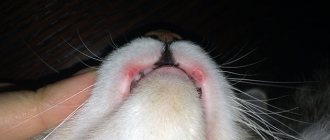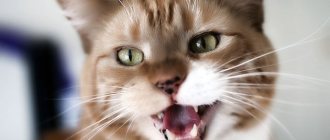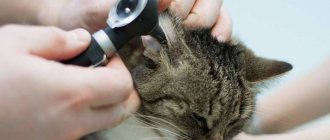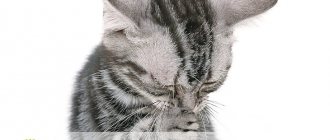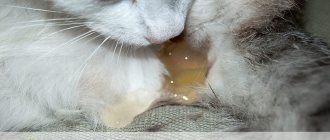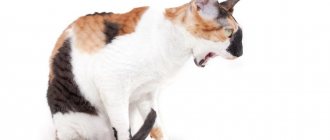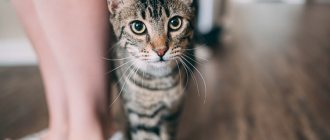Cats are extremely curious - they walk in and around the house, exploring everything that comes along the way. Their excellent sense of smell allows them to navigate their surroundings and receive information about other animals.
From time to time, you may notice how, after sniffing an object, your pet leaves his mouth open for a few seconds. He also wrinkles his nose and raises his upper lip (usually people do this when they smell an unpleasant odor). However, after the initial sniffing and grimacing, the cat may fall into a trance-like state. From a human point of view, the animal's behavior looks very strange.
What's really going on? Does the cat have an aversion to the smell, is she traumatized, or is the reason for something completely different?
It turns out that sniffing with an open mouth is caused by the so-called Flehmen reaction (smile) and is a completely normal phenomenon. Inside the cat's mouth, on the palate behind the teeth, there is a vomeronasal organ (also known as Jacobson's organ). It is small in size and consists of two fluid-filled sacs connected to the nasal cavity. By leaving the mouth open after sniffing the object, the animal draws in air, which enters the vomeronasal organ, and examines the aroma more carefully. This information enters the brain. Thanks to its specific olfactory system, cats are 14 times more sensitive to odors than humans. Additional sniffing allows pets to form a more complete picture of the world around them.
What odors trigger the Flehmen reaction?
You may have noticed that your cat doesn’t show a strange “facial expression” after every sniff. The fact is that not all objects and parts of the house are subject to additional examination. The function of Jacobson's organ is to recognize pheromones - chemical substances secreted by animals to communicate with relatives. Secretion is carried out through glands located on the face, paws and anus. With the help of pheromones, cats declare their territorial rights, leaving marks for neighbors and strangers.
Flemen's smile usually appears after sniffing the urine and excrement of other animals, because... they contain pheromones. Also, these substances can remain on furniture and even on people. Additional sniffing allows males to identify a cat that is ready to mate, and mother cats to track the path of the cubs.
Furry members of the household often rub their faces against household items to leave their pheromones on it. For a cat, these substances are indicators of calm and awareness; In this way, the animal reminds itself and tells its relatives that this place is safe. For the same purposes, pets can scratch things.
Feline chronic gingivostomatitis
Feline gingivostomatitis is an inflammation of the oral cavity (gums, corners of the mouth), with the formation of wounds or ulcers around the teeth and on the mucous membrane.
Sometimes inflammation has an obvious cause - for example, eating aggressive ingredients (chemical/thermal) or mechanical damage.
The condition is extremely painful and can often cause affected cats to stop eating.
Clinical signs:
Cats with gingivostomatitis often stop eating suddenly and without warning. They may drink water frequently (polydipsia) and may approach food without eating it (anorexia). Excessive salivation (hypersalivation), sometimes mixed with blood, is common. If the cat does try to eat, it may become awkward, even causing pieces of food to fall out of its mouth. Sometimes a hungry animal swallows large pieces of food without chewing, which can lead to stomach upsets in the future. The cat may wash itself more often, thoroughly rubbing the mouth area, as if something is bothering it there.
Diagnosis of gingivostomatitis:
Gingivitis and stomatitis are easily diagnosed visually—your veterinarian will be able to see red, inflamed gums and oral mucosa as soon as he opens your cat's mouth. An unpleasant odor is common and may be due to a bacterial or fungal infection. Next, you need to determine the type of stomatitis to find out the causes of inflammation.
There are several types of inflammation and their localization:
| Catarrh Catarrhal stomatitis occurs most often - the beginning of all complicated stomatitis in the case of improper or neglected treatment. Classic signs of inflammation are intense redness, swelling, sore gums, increased salivation, and unpleasant odor from the mouth. Plaque may appear on the gums and inner surface of the cheeks. Often develops against the background of diseased teeth or tartar. The saliva is viscous and smells unpleasant. |
| Papillomatous stomatitis This is the result of the life activity of the papilloma virus in the cat’s body, i.e. full-fledged viral stomatitis. In the area of the cheeks and lips, cauliflower-shaped growths form on the mucous membrane. With normal functioning of the immune system, after 7-12 weeks everything goes away on its own as suddenly as it appeared. If this does not happen, surgical removal of papillomas will be accompanied by appropriate antiviral and immunostimulating therapy. |
| Diphtheritic form It is very rare in cats and is manifested by the formation of a white coating, which is difficult to remove, and underneath there are areas of even greater inflammation or even bleeding ulcers. |
| Phlegmonous stomatitis It is characterized by an accumulation of pus under the first thin layer of mucous membrane, which changes color from bright pink to gray and bluish. When the places of such accumulations are punctured, pus is released. The risks of sepsis (blood poisoning) are very high; oral cleaning is often carried out under general anesthesia. |
| Gangrenous stomatitis In most cases, it is a complication of ulcerative or phlegmonous. The mucous membrane simply begins to die. A sharp, foul odor emanates from the mouth. Surgical stripping of the affected tissue is clearly indicated. There are high risks of developing sepsis and death of the pet. Often accompanied by fever and enlarged submandibular lymph nodes. |
| Ulcerative form Ulcerative - weeping ulcers are found over the entire surface or in places, the size and depth of which depends on the cause of occurrence and the duration of the disease. Body temperature may rise. If during the treatment the healing of ulcers does not occur correctly, then this form develops into ulcerative stomatitis with granulations (overgrowth with pathological connective tissue) and, further, into necrosis (complete death of the mucous membrane with complete disruption of its functions). |
| Autoimmune (immune-mediated stomatitis cats or chronic lymphocytic gingivostomatitis) A special form of stomatitis, in which inflammation develops against the background of the body’s rejection of its own teeth. Very clear signs of inflammation are observed right around the dental arcades, and near all of them. The course is greatly complicated when infectious agents are attached. Conventional treatment according to the classical scheme does not produce absolutely any results. Tooth extraction cannot be avoided. |
| Uremic syndrome The most severe complication of chronic renal failure. Usually precedes the death of the animal. This form of stomatitis can only be determined using laboratory blood tests. It occurs due to toxic substances that accumulate in the blood of a sick animal, causing irritation and inflammation from the inside. |
Causes of gingivostomatitis
The exact cause of feline chronic gingivostomatitis has not been proven. However, veterinary experts believe it is likely caused by a combination of a bacterial or fungal infection with feline calcivirus and an abnormally low immune response in the mouth. The root cause may be ordinary trauma, followed by the addition of a viral or bacterial infection.
Diagnosis of gingivostomatitis
When examining your cat, your veterinarian will pay attention to the following points:
• Your cat's lifestyle and diet, as well as vaccinations.
• If necessary, a clinical blood test can be taken to know how much inflammation is present.
• Sometimes it makes sense to test for the presence of calicivirus and other viral infections.
Treatment
Chronic gingivostomatitis is extremely difficult to treat. This problem cannot be left untreated, as the condition is very painful.
The following measures can be taken:
Antiseptics and disinfectant solutions: it is recommended to use antiseptics throughout the entire period of treatment to prevent re-infection during treatment through ulcers, which are a constant gateway to infection. Typically used:
1) Lugol's solution for stomatitis shows excellent disinfecting properties: to treat ulcers directly - smear or spray. Important: long-term use is avoided, because can provoke the proliferation of Pseudomonas aeruginosa, which is not affected by iodine;
2) Chlorhexidine 0.05% - for washing the mouth or treating wounds and ulcers;
3) Dentavedin gel is used up to 2-3 times a day, applied in a thin layer to sore gums, or placed directly into the sockets after tooth extraction;
4) Metrogil-denta in the form of a gel is applied in a very thin layer to areas of inflammation or ulceration. It is important not to overdose, so as not to provoke increased side effects - vomiting, thirst, indigestion, loss of appetite;
5) 1-5% solution of Protargol - irrigate the oral cavity in case of inflammation or cauterize ulcers, wounds or places to remove papillomas with the same type of stomatitis.
6) An aqueous solution of methylene blue for the treatment of single ulcers.
Important! Rotocan is rarely used to treat the mouth of cats, since in most cases it provokes excessive salivation.
Antibiotic therapy: Although bacterial microflora is not the only cause of the problem, its presence often aggravates the condition.
1) Lincomycin 10% - course from 3 to 7 days at a dose of 2 ml/10 kg for intramuscular administration and 1 ml/10 kg for intravenous administration;
2) Amoxicillin 15% - a single dose of 1 ml/10 kg (or 15 mg/kg) under the skin or into the muscle; if necessary, you can re-inject after 48 hours;
3) Oxytetracycline – 0.1 ml/kg body weight once a day for up to 5 days (minimum 3);
4) Nystatin and oxolinic ointments, Levorin, Cholisal and Kamistad gels - applied topically to areas of inflammation and ulceration in a very thin layer, avoiding overdose; have antifungal, antiviral, anti-inflammatory, wound healing and analgesic effects.
Anti-inflammatory therapy: Anti-inflammatory drugs are prescribed to reduce redness or soreness. There are two main types of anti-inflammatory drugs:
Corticosteroids can be given daily as tablets or injections. These drugs relieve inflammation well, after which the cat feels better, and they also have the positive side effect of stimulating appetite, which is very important for this problem. However, long-term use of steroids can cause unwanted side effects, for example, in rare cases they can lead to immunosuppression, leading to the development of a viral or bacterial infection.
NSAIDs (non-steroidal anti-inflammatory drugs) are generally considered safe and are widely used in these cases. Usually used in the form of injections and in the form of drops that are administered into food or directly into the mouth. NSAIDs are recommended for use in combination with gastroprotectors (due to their negative effect on the gastrointestinal tract), and the course should last no more than 5 days (exception: the drug Metacam, a course of up to 14 days is possible).
Immunostimulants: used to stimulate the immune system and enhance the body’s response to the virus and external factors. Apply:
1) Gamavit – 0.3-0.5 ml/kg once a day up to 3 times every 7 days for 2-4 weeks.
2) Catozal – 0.5-2.5 ml/animal, depending on the size and severity of the condition, once, repeated after 3-5 days (as necessary);
Dental care - Any tartar will aggravate the inflammation, even if they are not the underlying cause. In more severe cases, it is possible to remove all molar teeth (even if they are healthy).
If conservative treatment is not possible, surgical removal of the affected mucosal tissue that has undergone changes is performed.
Diet - Choose a diet that is easier for your cat to accept (usually canned soft food). Food should be at room temperature.
Stress – In some cats, stress also plays a role in triggering gingivostomatitis outbreaks. Removing stressors or giving your cat a “safe” place can help in these cases.
There is evidence that the condition of 80% of cats with gingivostomatitis improves significantly, even to complete recovery, by extraction of all teeth, in combination with the other measures listed above. However, not all treatments are suitable for all cats. There are also some cases where the animal does not respond completely to treatment, regardless of the procedures performed. Therefore, some cats require constant monitoring and/or repeated treatment throughout their lives.
Sources
www.acornhousevets.com www.dentalvets.co.uk
www.zoosecrets.ru
Author: Antonskaya Valentina
Flehmen reaction and urine markings
A pet exploring the space around the house with its mouth open is most likely “collecting” the smells of other animals. Because Flemen's smile often appears when sniffing urine; it is quite possible that someone else's cat has left its marks near your home.
When members of the cat family make urine marks, they explain to their relatives that the territory belongs to them. The desire to mark objects is typical for non-castrated cats, which thus communicate their readiness to mate. Animals that are stressed or anxious may mark furniture; it gives them a feeling of security because... the smell scares away strangers and reminds you of being in a familiar place. A change in the environment in the house, a move, or the arrival of a new family member can cause a negative psychological state in a cat.
If your furry friend often relieves himself in the wrong place, ignoring the litter box, you should contact your veterinarian; Your pet may be suffering from urinary problems associated with some medical condition.
